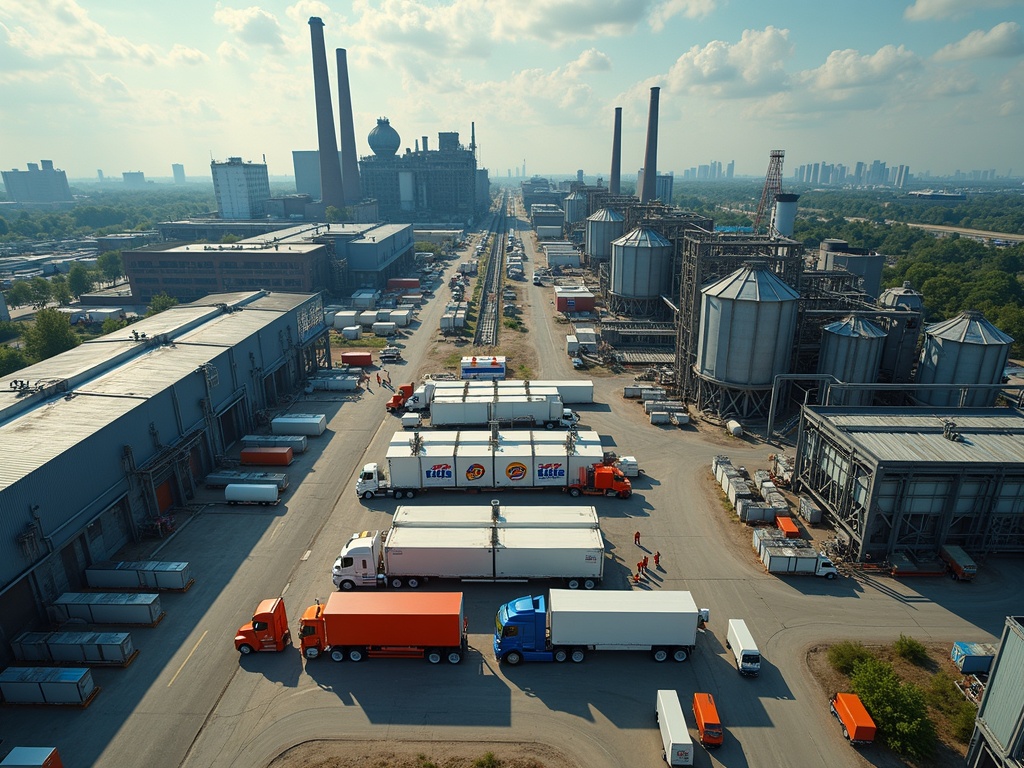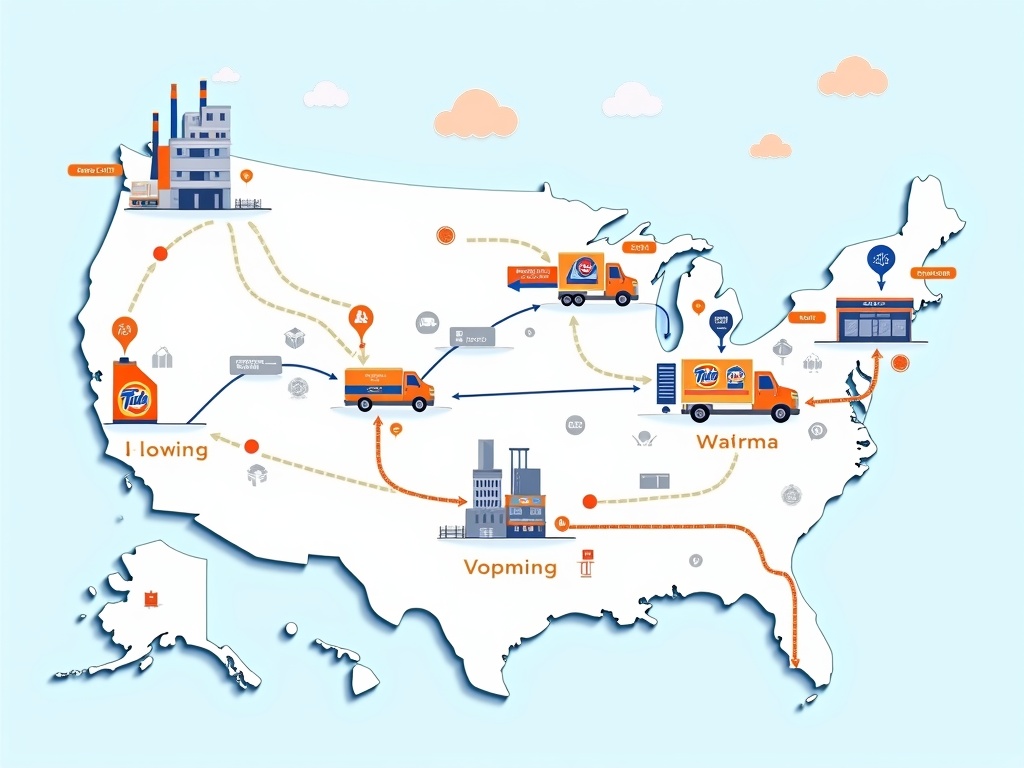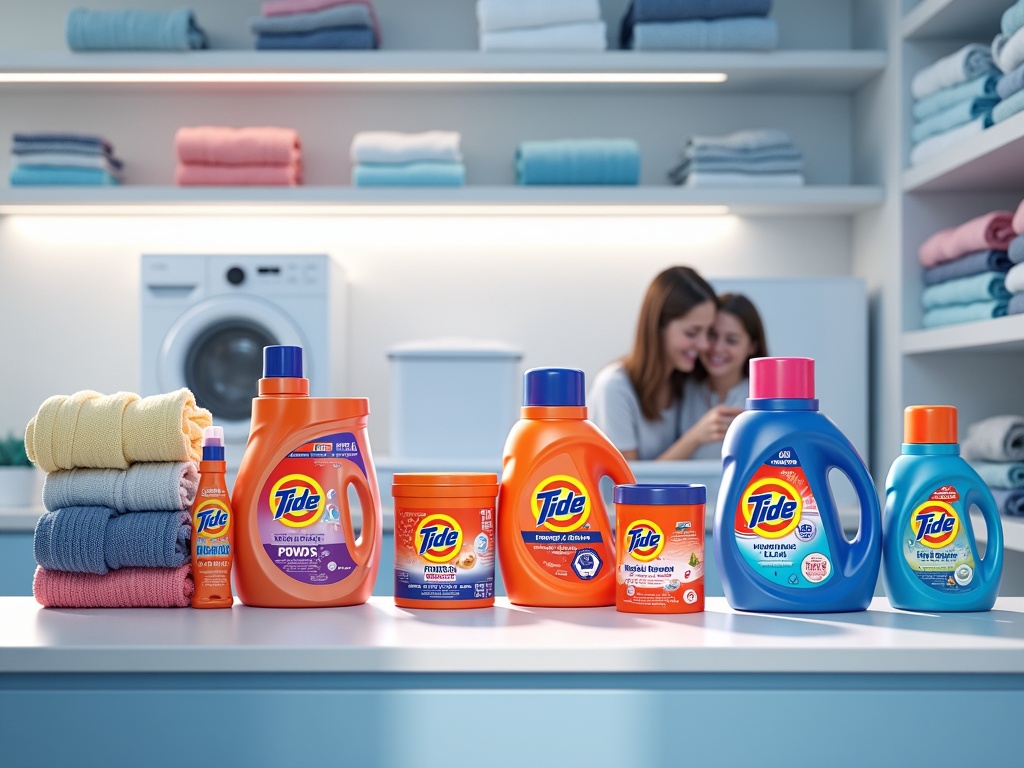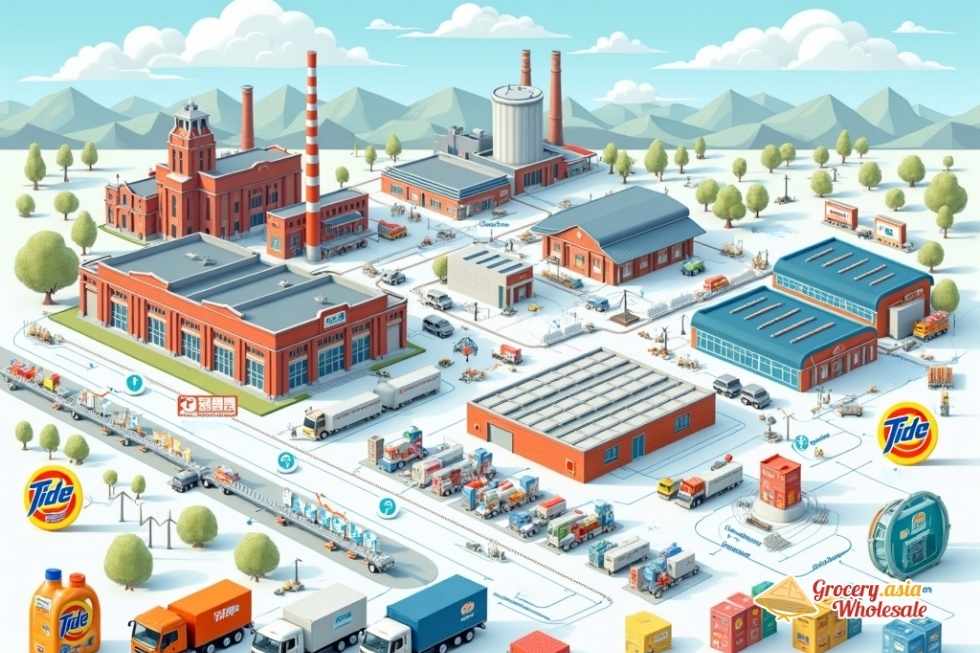No products in the cart.
Home Care, Laundry Detergent, Tide Powder Detergent
Where Is Tide Laundry Detergent Made And Distributed
Tide laundry detergent is manufactured at multiple strategic locations and distributed through an extensive global network, which solidifies its reputation as a market leader in laundry care.
Table of Contents
Key Takeaways
- Tide’s primary U.S. facilities are located in St. Louis, Missouri (operating since 1928), Lima, Ohio (home to one of the largest liquid detergent plants), and Pineville, Louisiana (focused on the production of Tide PODS).
- Market dominance: Tide captures over 40% of the U.S. liquid detergent market share and reaches 98% of American households through major retailers such as Walmart, Kroger, and Target.
- Global production strategy: Tide follows a “produce locally, sell locally” model, with additional facilities in Amiens, France and Tianjin, China. In many international markets, the Ariel brand serves as Tide’s equivalent.
- Efficient distribution: Regional distribution centers work closely with both retailers and e-commerce platforms. These operations are supported by advanced inventory management and logistics technology to ensure reliable product availability.
- Sustainability initiatives: Tide is on track to use 100% renewable energy for all production sites by 2030. The company is also focused on water-saving technologies and innovations like the Tide Eco-Box, which reduces plastic usage by 60% compared to traditional packaging.
American Manufacturing: Tide’s U.S. Production Facilities
I’ve discovered that the vast majority of Tide sold across North America comes from strategically located manufacturing plants right here in the United States. These facilities represent decades of investment and innovation in Tide laundry detergent production.
Historic St. Louis Manufacturing Hub
The St. Louis, Missouri plant stands as a cornerstone of American detergent manufacturing, having operated since 1928. This massive facility spans over 1.5 million square feet and produces both liquid and powder formulations of Tide. Its longevity speaks to the strategic importance P&G places on domestic production capabilities, ensuring consistent supply chains and quality control for American consumers.
Major Production Centers Across America
Beyond St. Louis, several other key facilities power Tide’s American manufacturing network:
- The Lima, Ohio plant operates as one of the world’s largest liquid detergent manufacturing facilities, employing approximately 1,800 people and producing Tide alongside other major brands like Gain and Downy.
- The Pineville, Louisiana plant specializes in manufacturing Tide PODS, having received a significant $110 million expansion to increase production capacity.
- Each facility produces multiple P&G brands simultaneously, maximizing operational efficiency and resource utilization.
These plants collectively employ thousands of workers and represent billions in infrastructure investment. The facilities use advanced automation and quality control systems to maintain consistent product standards. Each location was chosen for strategic advantages including transportation access, workforce availability, and proximity to raw material suppliers.
The domestic manufacturing approach allows P&G to maintain tight quality control while reducing shipping costs and delivery times to major American markets. This strategy also provides supply chain resilience during global disruptions. Manufacturing locations continue expanding as demand grows, with ongoing investments in both capacity and technology upgrades across all major facilities.

From Factory to Your Home: Tide’s Distribution Network
I’ve traced Tide’s journey from its production facilities to your laundry room, and the scale of this operation is impressive. After Tide detergent manufacturing completes at facilities like Lima, Ohio, the products begin their carefully coordinated journey across America.
The distribution process starts when finished products leave the factory floor and head to regional distribution centers strategically positioned throughout the United States. These DCs act as crucial staging points in the supply chain. For instance, Tide produced in Lima, Ohio travels to a distribution center in Inwood, West Virginia, where it’s sorted and prepared for delivery to retail locations.
Reaching Every Corner of America
From these regional hubs, Tide products fan out to major retailers that form the backbone of American shopping. The brand reaches consumers through several key channels:
- Walmart stores nationwide, leveraging the retailer’s extensive footprint
- Kroger supermarkets, serving communities across multiple states
- Target locations, bringing Tide to suburban and urban shoppers
- Independent grocery stores and regional chains
- Online platforms for direct-to-consumer delivery
P&G’s distribution infrastructure supports this massive undertaking with precision logistics that ensure consistent product availability. The company’s global supply chain serves more than 5 billion consumers worldwide, with Tide laundry detergent representing one of their most successful distribution achievements.
The results speak for themselves – Tide maintains an estimated presence in 98% of U.S. homes. This remarkable penetration rate reflects both the brand’s popularity and the effectiveness of P&G’s distribution strategy. Each link in this chain, from factory loading docks to retail shelves, works in coordination to maintain the steady flow of products that keeps America’s laundry rooms stocked.
Advanced inventory management systems track products at every stage, ensuring retailers receive fresh stock before shelves empty. This systematic approach has made Tide’s detergent legacy possible by guaranteeing consumers can find their preferred products whenever they need them.

Market Dominance: America’s #1 Laundry Detergent
I’ve witnessed Tide’s remarkable journey to become America’s undisputed laundry leader. The brand commands over 40% of the U.S. liquid detergent market share, establishing a dominance that leaves competitors far behind. Gain, which also belongs to P&G’s portfolio, holds second place with just 15–20% market share — less than half of Tide’s commanding presence.
Innovation Drives Success
Tide’s market leadership stems from relentless product innovation and strategic brand management. The company continuously develops new formulations and delivery systems that address evolving consumer needs. Each product launch builds upon decades of research and development, reinforcing the brand’s reputation for cleaning performance.
Comprehensive Product Portfolio
The brand’s diverse product lineup enables it to capture multiple market segments effectively. Here’s how Tide addresses different consumer preferences:
- Tide Original delivers the classic cleaning power that built the brand’s reputation
- Tide PODS offer convenient 3-in-1 and 4-in-1 Ultra Oxi formulations for busy households
- Tide Hygienic Clean targets health-conscious consumers seeking enhanced sanitization
- Tide with Downy combines cleaning and fabric softening in one product
- Tide Free & Gentle serves customers with sensitive skin or fragrance sensitivities
- Tide Simply provides budget-friendly options without compromising quality
- Tide with Bleach Alternative offers whitening power for specific laundry needs
This strategic product differentiation allows Tide to compete across price points while maintaining premium positioning. Budget-conscious shoppers can choose Tide Simply, while those seeking advanced features opt for specialty formulations like PODS or Hygienic Clean.
The brand’s manufacturing excellence supports this market dominance. Tide’s production facilities maintain consistent quality across all product variants, ensuring every item meets the performance standards consumers expect. This reliability has built tremendous brand loyalty over generations of users.
Tide’s success also reflects P&G’s deep understanding of American laundry habits and preferences. The company invests heavily in consumer research, allowing them to anticipate market trends and develop products that address real household challenges. This consumer-centric approach has helped Tide maintain its legacy while adapting to changing lifestyles and cleaning requirements.

Global Production and Tide’s Sister Brand Ariel
Beyond North America’s borders, Procter & Gamble implements a strategic “produce locally, sell locally” approach that fundamentally shapes how Tide detergent is manufactured across different continents. This production philosophy drives the company’s decision to establish major manufacturing facilities in key regional hubs rather than relying solely on exports from American plants.
Strategic Manufacturing Locations
Two primary production centers anchor Tide’s international manufacturing network. The Amiens facility in France serves as the European manufacturing hub, producing detergent formulations specifically designed for European water conditions and consumer preferences. Meanwhile, the Tianjin plant in China functions as the Asian production center, supplying Tide products across Vietnam and other regional markets.
This localized production strategy delivers multiple operational advantages that benefit both the company and consumers:
- Reduced transportation costs through shorter supply chains
- Faster response times to regional demand fluctuations
- Customized formulations that address local water hardness levels
- Lower environmental impact from decreased shipping distances
- Enhanced supply chain resilience during global disruptions
Regional water chemistry plays a particularly crucial role in determining specific formulations. European water tends to be harder than American water, requiring adjusted enzyme and surfactant concentrations. Asian markets present even more diverse water conditions, from the soft water common in coastal areas to the extremely hard water found in certain inland regions.
Tide’s International Counterpart: Ariel
In many international markets, consumers encounter Ariel rather than the familiar Tide branding. Ariel essentially functions as Tide’s international equivalent, occupying the same premium market position and utilizing virtually identical cleaning technology. Both brands share the same core surfactant systems, enzyme packages, and stain-fighting capabilities that define P&G’s premium laundry segment.
The decision to maintain separate brand identities stems from historical market entry strategies and existing brand equity in different regions. Ariel established strong consumer recognition in Europe and parts of Asia decades before Tide’s international expansion began. Rather than rebrand established products, P&G maintains both identities while ensuring consistent product quality and performance standards across all markets.
This dual-brand approach allows P&G to leverage Tide’s established reputation in North America while respecting Ariel’s market position elsewhere. Both products undergo identical quality control processes and share research and development innovations, ensuring consumers receive the same premium cleaning performance regardless of which brand name appears on the package.
Where Is Tide Laundry Detergent Made and Distributed? The Direct Answer
Primary Manufacturing Locations in the United States
Tide detergent manufacturing operates primarily from three major facilities across the United States. These strategic locations include St. Louis, Missouri; Lima, Ohio; and Pineville, Louisiana. Each facility produces different formulations and packaging sizes to meet varying consumer demands across different regions.
The St. Louis plant serves as one of the largest production centers, handling both liquid and powder formulations. Lima, Ohio focuses heavily on liquid detergent production, while the Pineville facility specializes in concentrated formulas and eco-friendly variants. This distributed manufacturing approach allows Procter & Gamble to reduce shipping costs and maintain consistent product availability throughout North America.
Global Manufacturing and Distribution Network
P&G extends Tide’s manufacturing footprint well beyond American borders through carefully positioned facilities across multiple continents. The company operates production sites throughout Europe, Asia, and Latin America to serve international markets effectively. These facilities produce region-specific formulations that account for local water conditions, washing machine types, and consumer preferences.
The global distribution network ensures Tide laundry detergent reaches more than 200 markets worldwide. This extensive reach makes Tide one of the most widely available laundry brands globally. The supply chain operates through regional distribution centers that coordinate with local retailers, ensuring consistent stock levels and product freshness.
In Asia, particularly in Vietnam, P&G has established significant manufacturing capabilities. Tide detergent in Vietnam is produced locally to serve both domestic and regional export markets. This local production strategy reduces costs while maintaining the quality standards that consumers expect from the brand.
The distribution system relies on partnerships with:
- Major retailers
- Independent stores
- E-commerce platforms
Nearly every U.S. household has access to Tide products through this comprehensive network. The company maintains strategic inventory levels at distribution centers to prevent stockouts while minimizing storage costs.
P&G’s manufacturing strategy emphasizes flexibility and responsiveness to market demands. Production schedules adjust based on:
- Seasonal patterns
- Promotional activities
- Regional preferences
This adaptive approach ensures optimal product availability while maintaining cost efficiency across the entire supply chain.
The company also leverages advanced logistics technology to optimize shipping routes and delivery schedules. This technological integration reduces transportation costs and environmental impact while improving delivery reliability. Regional manufacturing reduces the need for long-distance shipping, further supporting sustainability goals.
Quality control measures remain consistent across all manufacturing locations, regardless of geography. Each facility follows identical testing protocols and production standards to ensure product consistency. This standardization guarantees that consumers receive the same quality experience whether they purchase Tide in Missouri or Vietnam.
The Tide detergent legacy continues to expand through strategic manufacturing investments and distribution partnerships. P&G regularly evaluates new market opportunities and adjusts production capacity accordingly. This proactive approach has enabled Tide to maintain its position as a leading laundry detergent brand across diverse global markets.
Manufacturing efficiency improvements focus on:
- Reducing waste
- Lowering energy consumption
- Minimizing water usage
These initiatives support both cost reduction and environmental responsibility goals. The company continues investing in modern equipment and sustainable production practices across all facilities.
Tide’s Environmental and Sustainability Initiatives
P&G has established ambitious environmental targets that directly impact Tide’s manufacturing operations across their global production facilities. I’ve observed their commitment to transitioning all manufacturing sites to renewable energy sources while simultaneously increasing energy efficiency throughout their production processes. By 2030, the company aims to power all Tide production using 100% renewable or recycled electricity, representing a significant shift in how this iconic detergent reaches consumers.
Packaging Innovation and Water Conservation
The company has revolutionized its packaging approach through several key innovations that reduce environmental impact:
- Recyclable materials integrated into all new packaging designs
- Concentrated detergent formulas requiring significantly less plastic per load
- Advanced packaging engineering that maintains product integrity while using fewer resources
- Strategic partnerships with recycling facilities to improve end-of-life packaging processing
The Tide Eco-Box exemplifies this innovative approach, utilizing 60% less plastic compared to traditional containers while requiring 30% less water during production. This concentrated formula delivers the same cleaning power consumers expect while dramatically reducing the environmental footprint of each package.
P&G’s manufacturing facilities have also implemented water conservation systems that capture and reuse process water, reducing overall consumption by substantial margins. These systems filter and treat wastewater on-site, allowing multiple uses of the same water throughout the production cycle.
Beyond manufacturing improvements, P&G has launched the ‘Turn to Cold’ campaign, which educates consumers about cold-water washing benefits. This initiative can cut energy use per laundry load by up to 90%, demonstrating how Tide’s environmental impact extends beyond production into actual usage patterns.
The company has invested heavily in research facilities that develop new formulations requiring lower temperatures for effective cleaning. These innovations ensure that environmental responsibility doesn’t compromise cleaning performance, maintaining the quality standards that have made Tide a household staple for decades.
Manufacturing sites now incorporate solar panels, wind energy systems, and other renewable sources to power production lines. I’ve seen how these changes reduce carbon emissions while often decreasing operational costs, creating a sustainable business model that benefits both the environment and the company’s bottom line.
Sources:
Procter & Gamble – “P&G Announces Fourth Quarter and Fiscal Year 2023 Results”
Procter & Gamble – “P&G U.S. Operations & Locations”
Statista – “Market share of the leading liquid laundry detergents in the U.S.”
Trade and Industry Development – “P&G Expanding Plant in Pineville, Louisiana”
St. Louis Post-Dispatch – “Inside P&G’s north St. Louis plant”


